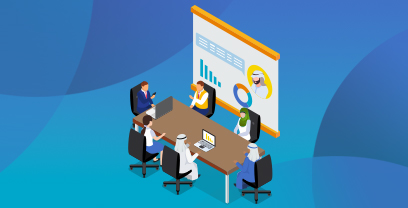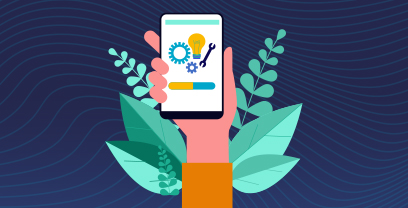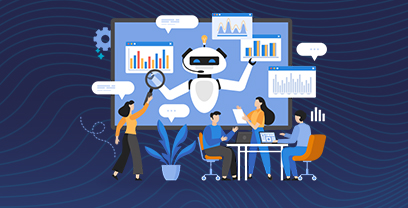Imagine transforming the most cumbersome and error-prone aspects of your business into a streamlined, efficient process that not only saves time and money but also empowers your team to focus on what truly matters.
That’s the idea behind procurement automation—to streamline and automate the time-consuming manual tasks typically associated with procurement. Not only can procurement automation save teams time and hassle – it leads to significant savings, better accuracy, and happier suppliers.
Organizations can spend more than 70% of their total revenue on procurement – and with such a significant investment, it’s crucial to leverage AI-powered technologies to device efficiency, cost savings and differentiation through procurement automation. If your organization isn’t already thinking about procurement automation, it’s time to start.
In this post, we’ll take a close look at what procurement transformation looks like, with a focus on Procure-to-Pay automation. You’ll learn all about procurement automation and why it’s important, what steps to take to get started, and how IKEA leverages Ivalua’s procurement platform to cut costs and improve efficiencies throughout the Procure-to-Pay process.
What is Procurement Automation?
Procurement automation refers to the use of technology and software solutions to streamline and automate the procurement process within an organization. This includes automating tasks such as requesting quotes and issuing purchase orders, vendor management automation, automated invoice processing, and automated payment reconciliation.
By leveraging automation software, organizations can reduce manual intervention, minimize errors, improve efficiency and optimize the procurement lifecycle, from requisition to payment.
Procurement automation software often incorporate features such as electronic catalogs, workflow automation, approval routing, electronic signatures and integration with accounting and ERP systems to ensure seamless and efficient procurement operations.
They help organizations enhance visibility and control over the procurement lifecycle, with real-time insights into all activities, spending trends and supplier performance.
Automated procurement holds immense importance for organizations as it revolutionizes the way businesses manage their supply chains and purchasing processes. By streamlining procurement processes, workflows, reducing manual tasks and accelerating processes, automation software enhances efficiency, productivity and agility.
What’s more, automation drives cost savings by optimizing spending and enabling organizations to identify cost-saving opportunities while enforcing data integrity and compliance with spend management policies.
Why Procurement Process Automation Is Important
There are numerous reasons to automate procurement processes. Let’s look at the benefits of automating some of the critical steps in procurement: purchase requisitions, approval workflows, invoice approvals and payments.
Procurement automation streamlines and optimizes purchase requisitions and approval workflows by providing a centralized platform for submitting, reviewing and approving purchase requests.
Instead of relying on manual paper-based processes or emails, employees can use the procurement automation system to create purchase requisitions electronically. These requisitions can be customized with relevant details such as item descriptions, quantities, preferred vendors and budget codes.
Once a purchase requisition is submitted, the automation system routes it through predefined approval workflows based on specified criteria such as the cost of the request, departmental budget limits and approval hierarchy. Approvers receive notifications and can review and approve requests directly within the system, speeding up the approval process and reducing delays.
Additionally, automation in procurement provides visibility into the status of purchase requisitions, allowing stakeholders to track progress, identify bottlenecks and take timely action as needed. This transparency improves communication and collaboration between requestors, approvers and procurement teams, leading to faster decision-making and better outcomes.
Procurement automation software simplifies and accelerates the invoice approval process by digitizing and automating key tasks. Supplier invoices can be scanned or electronically captured and uploaded into the automation system, eliminating manual data entry and reducing errors.
The automation platform then matches invoices against corresponding purchase orders and receipts, verifying the accuracy of billing information and ensuring compliance with agreed-upon terms and prices. It also flags any discrepancies or exceptions for review, reducing the risk of overpayments or duplicate payments.
Invoice validation triggers predefined approval workflows, enabling rapid approval without the need for paper-based approvals or manual signatures. The system can automatically queue approved invoices for payment according to scheduled payment runs, further reducing manual intervention and accelerating the payment cycle.
Ivalua’s integrations with accounting and ERP systems ensures seamless reconciliation and recording of payments, improving accuracy and compliance with financial reporting requirements.
By eliminating bottlenecks associated with manual data entry, approval routing and paperwork handling, automation in procurement reduces processing times and expedites the entire procurement process. Additionally, predictive analytics help organizations anticipate demand, identify cost-saving opportunities, and optimize procurement strategies, further enhancing efficiency and agility in procurement operations.
How to Start Automating The Procure-to-Pay Process
A key step in procurement automation is to automate the Procure-to-Pay process. Procure-to-Pay encompasses the entire procurement process, including requisitioning, sourcing, purchasing, receiving, invoicing and payment. P2P automation typically involves the use of software platforms that integrate with an organization’s ERP system and other financial tools to automate and standardize digital procurement workflows.
Key features of P2P automation include electronic purchase requisitions, automated vendor selection and sourcing, electronic purchase orders, receipt verification, invoice matching, approval workflows, and electronic payments. By automating these processes, P2P automation improves efficiency, reduces errors, enhances compliance and provides real-time visibility into procurement activities and spending.
Read this blog post to learn more about the Procure-to-Pay process. If you’re interested in learning more about the differences between Procure-to-Pay and Source-to-Pay, you can read about it here.
Benefits of Procure-to-Pay (P2P) Automation
Automating the Procure-to-Pay process delivers numerous benefits. Here are the top five:
- Cost Savings: Through automation, organizations can negotiate better terms with suppliers, consolidate purchasing volume to leverage discounts, and enforce compliance with negotiated contracts. Automation also reduces processing costs associated with manual data entry, paperwork handling, and invoice processing, leading to overall cost reductions and improved financial performance.
- Increased Productivity: Automating procurement processes increases productivity by streamlining workflows, eliminating manual tasks and reducing administrative overhead. Procurement professionals can spend less time on routine tasks such as data entry, approval routing and paperwork handling, and more time on strategic activities such as supplier relationship management, contract negotiation and process optimization. This enables organizations to achieve higher levels of efficiency and productivity in their procurement operations.
- Reduced Cycle Times: Automation reduces cycle times in the Procure-to-Pay process by accelerating approval workflows and improving process efficiency. Electronic submission and approval of purchase requisitions, automated invoice processing and electronic payments all contribute to faster processing times and shorter procurement cycles.
- Better Accuracy and Compliance: Procurement automation reduces the risk of errors and ensures compliance with organizational policies and regulatory requirements. By automating approval workflows, enforcing spending limits and providing audit trails for all procurement activities, organizations can improve accuracy, transparency and accountability.
- Enhanced Supplier Collaboration: Automation facilitates better communication and collaboration with suppliers, leading to stronger and more strategic supplier relationships. Automating order processing and performance monitoring also improves supplier responsiveness, reducing lead times.
Key Features and Functionalities of Procurement Automation Tools
When choosing a procurement automation platform, be sure to look for these key capabilities:
- Supplier Management Automation: Features such as supplier onboarding, performance tracking, contract management and communication portals help to effectively manage suppliers. They do this by centralizing supplier information, helping to assess supplier performance, monitoring compliance and making collaboration with suppliers easier. This helps to ensure timely delivery of goods and services.
- Purchase Order Generation and Management: A robust procurement automation platform automates the creation, approval and tracking of purchase orders (POs). Users can generate POs electronically, customize templates and route POs through predefined approval workflows. Real-time visibility into PO status enables effective tracking of deliveries and receipts, and facilitates communication between buyers and suppliers to ensure accurate and timely fulfillment of orders.
- Invoicing and Payment Processing Automation: This capability streamlines invoicing and payment, enabling organizations to receive invoices electronically, match them to corresponding purchase orders and receipts, and route them through approval workflows. Once approved, invoices are automatically queued for payment, and payments can be processed electronically, reducing manual intervention and accelerating the payment cycle.
- Data Analytics and Reporting Capabilities: Procurement automation platforms often include data analytics and reporting capabilities to provide actionable insights into procurement performance, spending trends and supplier relationships. Organizations can analyze procurement data, track key performance indicators (KPIs), and generate customized reports and dashboards. Using advanced analytics, they can identify opportunities for cost savings and process optimization.
Download our procurement automation checklist for tips on getting started with automating the Procure-to-Pay process.
Role of Artificial Intelligence (AI) in Procurement Automation
AI plays a crucial role in procurement automation by leveraging advanced algorithms and machine learning techniques to enhance decision-making, optimize strategic activities and mitigate supply chain disruptions. Using AI to analyze vast amounts of data – historical purchasing data, market trends, supplier performance metrics and external factors – organizations gain critical insights that support decision making.
AI-powered predictive analytics can forecast demand, anticipate price fluctuations and identify cost-saving opportunities. They can also support various strategic purchasing activities, such as supplier selection, contract negotiation and category management.
AI-driven contract management systems automate contract drafting, negotiation and renewal processes, ensuring compliance with legal and regulatory requirements and optimizing contract terms to maximize value.
AI enables organizations to mitigate supply chain disruptions by forecasting risks, enabling proactive risk mitigation strategies. It can be used to analyze a wide range of factors, such as supplier financial health, geopolitical events, natural disasters, to identify patterns and predict potential disruptions. Organizations are using AI to identify opportunities for cost savings, and optimize inventory levels, as well.
Generative AI has recently come to the forefront of procurement, enabling procurement professionals to automate time-intensive daily tasks and greatly improve their productivity. In minutes or even seconds, Generative AI-powered tools can:
- Gather research and data on suppliers,analyze supplier profiles and capabilities, and recommend suitable suppliers based on specific criteria and requirements.
- Provide assistant creating contract summaries or drafting contract clauses
- Summarize key trends within a procurement category
- Create and proofread content and communications
- Review and summarize supplier performance responses, and make recommended next steps for improvement
- Pull important information from documents such as ESG reports, contrats or 10K filings
As Generative AI technology continues to evolve, there’s potentially no limit to how it can contribute to creating a well-oiled, cost-efficient procurement machine.
Read Gartner’s: Predicts 2024: CPOs Adjust to Technology’s Impact on Procurement report
How IKEA Simplified & Future-Proofed Their Procurement Process with Ivalua
As it progressed along its digitalization journey, IKEA was looking to replace numerous single purpose applications with a single procurement platform, to gain transparency and control over all of its procurement data. The platform would be used for both the food and the furnishing sides of the business, to ensure standardized digital procurement practices and greater efficiency across the global organization.
Ivalua was instrumental in creating transparency for the whole supply chain.
Slawomir Jan Peter, Supply Chain Development Area Manager, IKEA
Working with Ivalua, IKEA automated much of the Procure-to-Pay process, significantly improving efficiency and reducing cycle times. In fact, the company was able to reduce turnaround time for contract management in its food business from 60 to just 3 days. Using Ivalua, IKEA also automated key processes in supplier selection, while boosting sustainability practices. Watch the interview with IKEA.
Conclusion
Speed, efficiency, accuracy and cost savings are critical for the success of modern procurement organizations in any industry, and automation is the key to achieving these goals. Whether expanding into new markets, adding new suppliers or scaling operations, automation tools can accommodate increased procurement volumes and complexity while maintaining efficiency and compliance. But finding the right partner and platform for your procurement transformation is an essential first step.
With its robust features, advanced capabilities and proven track record, Ivalua’s Procurement Platform offers organizations powerful automation capabilities to transform their procurement operations.
See why Gartner named Ivalua as a Leader in the 2024 Gartner® Magic Quadrant™ for Source-to-Pay Suites!




